Microsoft Bundle
How Did Microsoft Conquer the Tech World?
Imagine a world before user-friendly computers, then picture the birth of an empire that changed everything. Microsoft's story is a thrilling saga of innovation, starting with Microsoft SWOT Analysis, and evolving into a global technology leader. From its humble beginnings, this company has consistently redefined how we interact with technology. This is the history of Microsoft.
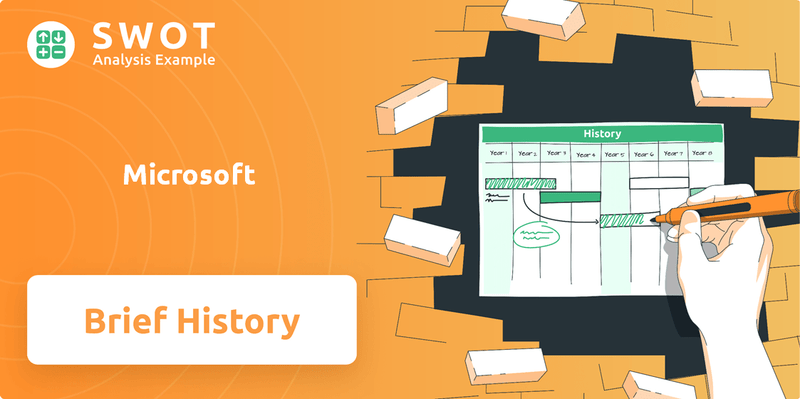
From its founding by Bill Gates and Paul Allen, the early days of Microsoft focused on software development, quickly gaining traction in the nascent personal computer market. Microsoft's evolution over time showcases its ability to adapt and dominate, from its early business strategies to its current position. The company's journey, marked by key milestones and achievements, offers valuable insights into the dynamics of the tech industry and the impact of Microsoft's Windows operating system history.
What is the Microsoft Founding Story?
The Microsoft history began on April 4, 1975. This was the day when Bill Gates and Paul Allen officially established the company. Their shared vision was to bring software to the forefront of the burgeoning personal computer revolution.
Both Microsoft founder Gates and Allen, childhood friends from Seattle, saw potential in the Altair 8800. This was one of the earliest personal computers. They aimed to create software that would make these machines more accessible and user-friendly.
Their initial focus was on developing and licensing BASIC interpreters for microcomputers. This marked the early days of Microsoft. Their first product was Altair BASIC, a programming language tailored for the Altair 8800.
The company's name, initially 'Micro-Soft,' was Allen's suggestion, later becoming 'Microsoft'. The founders, Bill Gates and Paul Allen, personally funded the company's initial operations.
- The company was officially founded on April 4, 1975.
- Bill Gates and Paul Allen were the co-founders.
- Their initial focus was on software for early personal computers.
- The first product was Altair BASIC.
Microsoft SWOT Analysis
- Complete SWOT Breakdown
- Fully Customizable
- Editable in Excel & Word
- Professional Formatting
- Investor-Ready Format
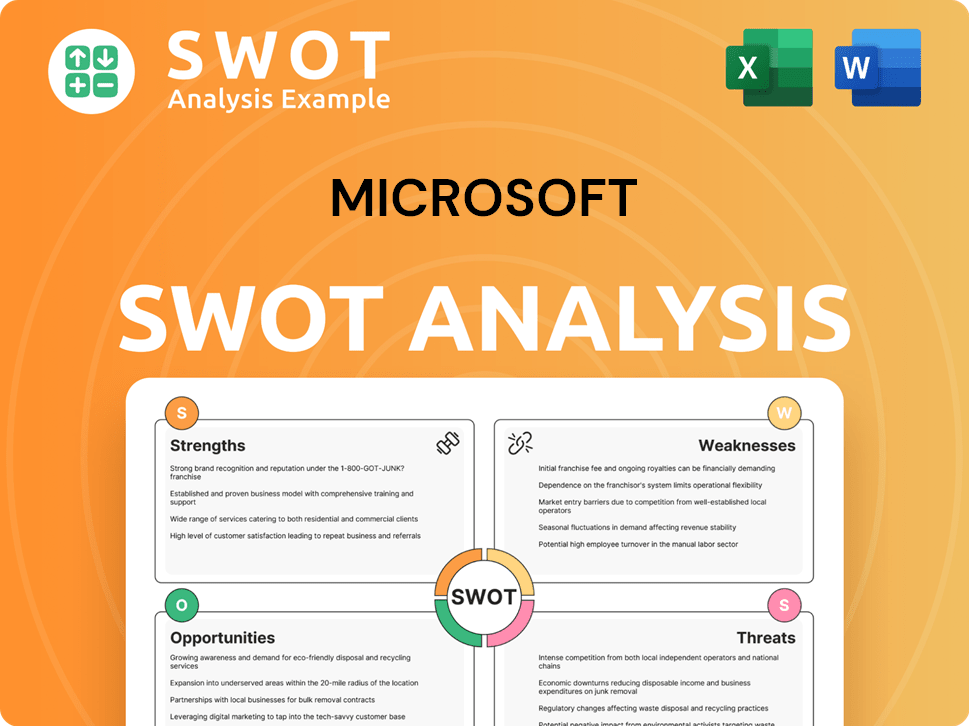
What Drove the Early Growth of Microsoft?
The early growth of the Microsoft company was significantly shaped by its strategic decisions. The company's licensing of MS-DOS to IBM for its original PC in 1981 was a pivotal move. This strategy allowed for widespread adoption across various PC manufacturers, establishing MS-DOS as the industry standard. The early days of Microsoft saw the launch of key applications like Microsoft Word and Microsoft Excel, which became essential in the productivity software market.
The decision to license MS-DOS to IBM was a cornerstone of Microsoft's early business strategies. This approach, rather than outright sales, facilitated broader distribution and adoption. By licensing the operating system, Microsoft ensured its presence on a wider range of hardware. This strategy set the stage for the company's future dominance in the software industry.
The mid-1980s witnessed the introduction of Microsoft Word and Microsoft Excel, which quickly became essential tools. These applications were crucial in establishing Microsoft's footprint in the productivity software market. The success of these products helped to cement the company's reputation for innovation and quality.
Microsoft went public in 1986, raising $61 million, which significantly impacted the Microsoft founder and many employees. This initial public offering (IPO) marked a significant milestone in the company's financial trajectory. The IPO allowed Microsoft to secure capital for further expansion and innovation.
Throughout the late 1980s and 1990s, Microsoft continued to expand rapidly, entering new markets with products like Windows. Windows 3.0, released in 1990, sold over 10 million copies. The company also expanded its team, moving to its iconic Redmond, Washington campus. For more details on Microsoft's growth strategy, see Growth Strategy of Microsoft.
Microsoft PESTLE Analysis
- Covers All 6 PESTLE Categories
- No Research Needed – Save Hours of Work
- Built by Experts, Trusted by Consultants
- Instant Download, Ready to Use
- 100% Editable, Fully Customizable
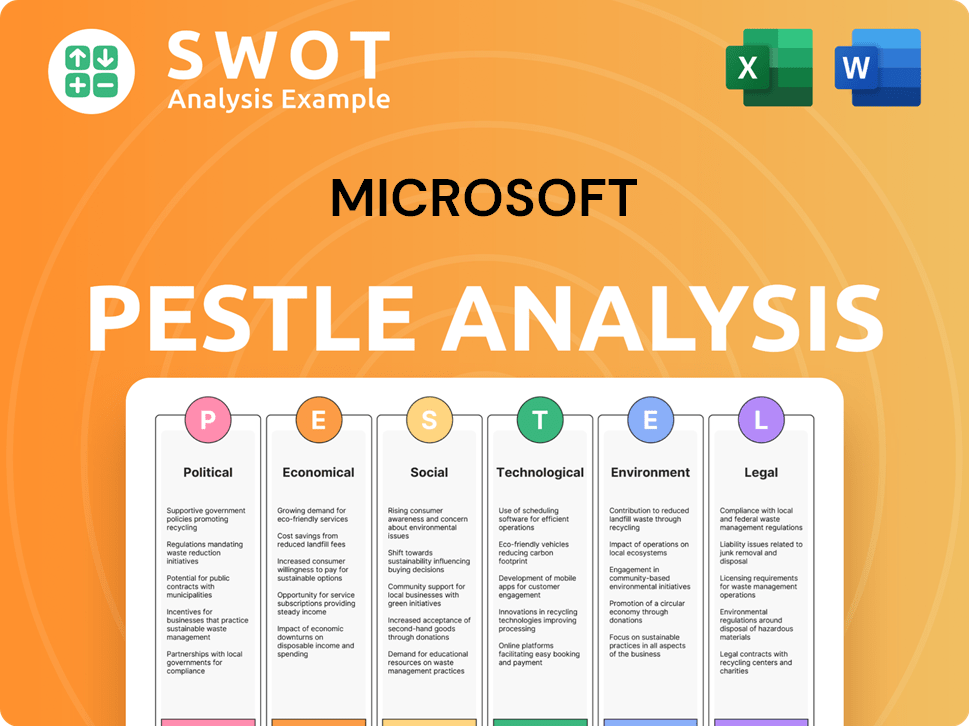
What are the key Milestones in Microsoft history?
The Microsoft company has a rich history marked by significant milestones that have shaped the tech industry. From its early days to its current status as a global leader, Microsoft's journey is filled with pivotal moments that showcase its adaptability and innovation.
| Year | Milestone |
|---|---|
| 1975 | Bill Gates and Paul Allen found Microsoft, marking the company's official start. |
| 1985 | Microsoft launches Windows 1.0, introducing a graphical user interface to personal computers. |
| 1995 | Windows 95 is released, revolutionizing the personal computing experience with its user-friendly interface. |
| 2001 | Microsoft enters the gaming industry with the launch of the Xbox console. |
| 2014 | Satya Nadella becomes CEO, initiating a strategic shift towards cloud computing and AI. |
Microsoft has consistently been at the forefront of technological advancements, driving innovation across various sectors. The company's commitment to research and development has resulted in groundbreaking products and services that have transformed how people work, communicate, and play.
Microsoft's Windows operating system has been a cornerstone of personal computing, consistently evolving to meet user needs. The Windows operating system has been a core product for decades, with continuous updates and new versions.
The Microsoft Office suite, including Word, Excel, and PowerPoint, has become a standard for productivity. These tools have become essential for businesses and individuals alike, facilitating document creation, data analysis, and presentations.
Azure, Microsoft's cloud computing platform, has been a transformative innovation, offering a wide range of services. Azure's revenue grew by 31% in the first quarter of fiscal year 2024, demonstrating its continued strong performance.
The Xbox gaming console marked Microsoft's successful entry into the competitive video game industry. Microsoft has consistently innovated in the gaming space, challenging established players.
Microsoft has invested heavily in artificial intelligence (AI), integrating AI capabilities into its products and services. This includes advancements in areas like machine learning, natural language processing, and computer vision.
Under Satya Nadella, Microsoft has embraced a more open-source approach, contributing to and supporting open-source projects. This shift has allowed Microsoft to collaborate more effectively with the developer community and integrate with a wider range of technologies.
Despite its successes, the Microsoft company has faced several challenges throughout its history. These hurdles have tested the company's resilience and forced it to adapt to changing market dynamics and technological shifts.
The antitrust lawsuit by the U.S. Department of Justice in 1998, alleging monopolistic practices, was a significant challenge. This led to intense scrutiny and a settlement that impacted Microsoft's business practices.
The Zune music player struggled to compete with Apple's iPod, representing a product failure for Microsoft. The company has learned from these experiences, adapting its strategies to better align with market demands.
Microsoft's Windows Phone strategy largely failed to gain significant market share against iOS and Android. This challenge highlighted the need for Microsoft to adapt to the rapidly evolving mobile landscape.
Intense competition from other tech giants, such as Apple, Google, and Amazon, has consistently challenged Microsoft. The company has had to continually innovate and adapt to stay ahead in the market.
Shifting consumer preferences and technological trends have required Microsoft to pivot its strategies. The company has demonstrated its ability to evolve and overcome adversity through strategic changes.
The increasing number of cybersecurity threats has posed a significant challenge, requiring Microsoft to invest heavily in security measures. The company has had to continuously update its security protocols.
Microsoft Business Model Canvas
- Complete 9-Block Business Model Canvas
- Effortlessly Communicate Your Business Strategy
- Investor-Ready BMC Format
- 100% Editable and Customizable
- Clear and Structured Layout
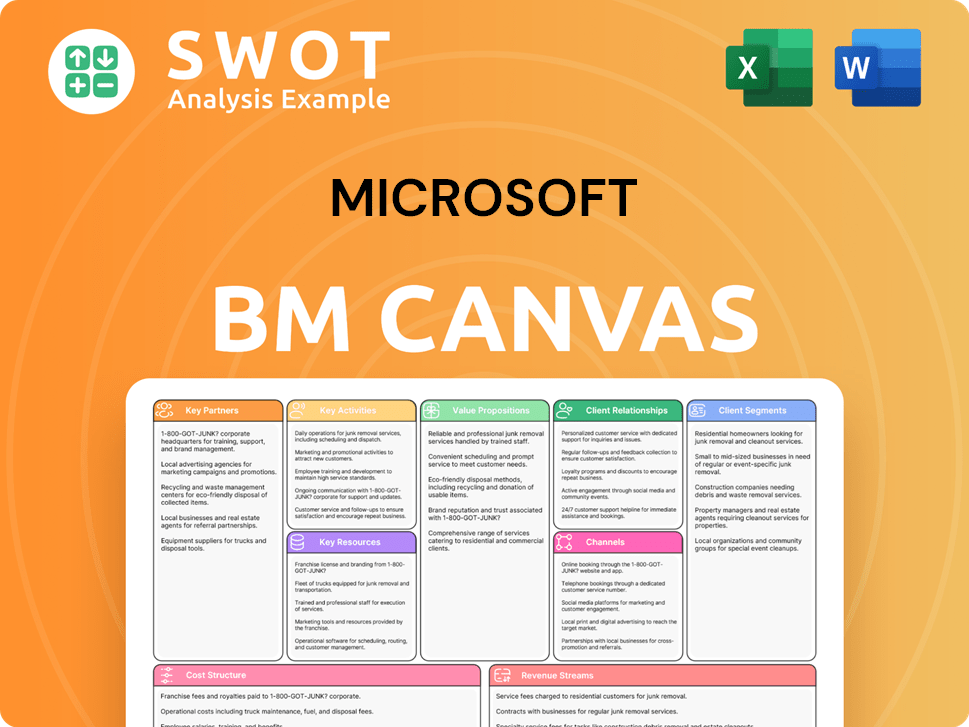
What is the Timeline of Key Events for Microsoft?
The Owners & Shareholders of Microsoft company has a rich history, marked by innovation and strategic shifts. From its inception in 1975 by Bill Gates and Paul Allen, it has evolved from a software provider to a global technology leader. The company's journey includes pivotal moments like the licensing of MS-DOS, the launch of Windows, and its entry into the gaming industry with Xbox. These events shaped the trajectory of the company and its impact on the tech world.
| Year | Key Event |
|---|---|
| 1975 | Founded by Bill Gates and Paul Allen, marking the early days of Microsoft. |
| 1981 | MS-DOS was licensed to IBM, establishing Microsoft's operating system dominance. |
| 1985 | Microsoft Windows 1.0 was released, introducing a graphical user interface. |
| 1986 | Microsoft went public, becoming a publicly traded company. |
| 1995 | Windows 95 launched, revolutionizing the personal computing interface. |
| 1998 | The U.S. Department of Justice filed an antitrust lawsuit against Microsoft. |
| 2001 | Xbox gaming console was released, entering the gaming industry. |
| 2009 | Bing search engine was launched, expanding its online services. |
| 2014 | Satya Nadella became CEO, initiating a strategic shift towards cloud and AI. |
| 2015 | Windows 10 was released as a 'service,' focusing on continuous updates. |
| 2016 | Microsoft acquired LinkedIn for $26.2 billion, expanding its professional network offerings. |
| 2021 | Windows 11 was released, introducing a new design and features. |
| 2022 | Microsoft announced the intent to acquire Activision Blizzard for $68.7 billion, a deal that closed in October 2023. |
| 2023 | Significant investments in AI, particularly with OpenAI, leading to the integration of AI across Microsoft products. |
Microsoft is heavily integrating AI across its product portfolio. This includes Microsoft 365 Copilot, which enhances productivity, and Azure AI services, which empower developers. This strategic move aims to solidify its position in the AI-driven market. The company's focus on AI is expected to drive significant growth.
Continued investment in Azure is a key area of focus for Microsoft. Azure is a leading cloud provider, and Microsoft is leveraging its position to drive substantial growth in this segment. The cloud computing market is experiencing rapid expansion, and Microsoft is well-positioned to capitalize on this trend.
The acquisition of Activision Blizzard has significantly bolstered Microsoft's gaming division. This move is expected to lead to further expansion, particularly in subscription services like Xbox Game Pass. The gaming industry is a major growth area, and Microsoft is aiming to increase its market share.
Microsoft is committed to responsible AI development and empowering individuals and organizations. The company aims to maintain its leadership in hybrid work solutions, cybersecurity, and sustainability. Analysts predict sustained growth, especially in the cloud and AI segments, making Microsoft a major force in the tech industry.
Microsoft Porter's Five Forces Analysis
- Covers All 5 Competitive Forces in Detail
- Structured for Consultants, Students, and Founders
- 100% Editable in Microsoft Word & Excel
- Instant Digital Download – Use Immediately
- Compatible with Mac & PC – Fully Unlocked
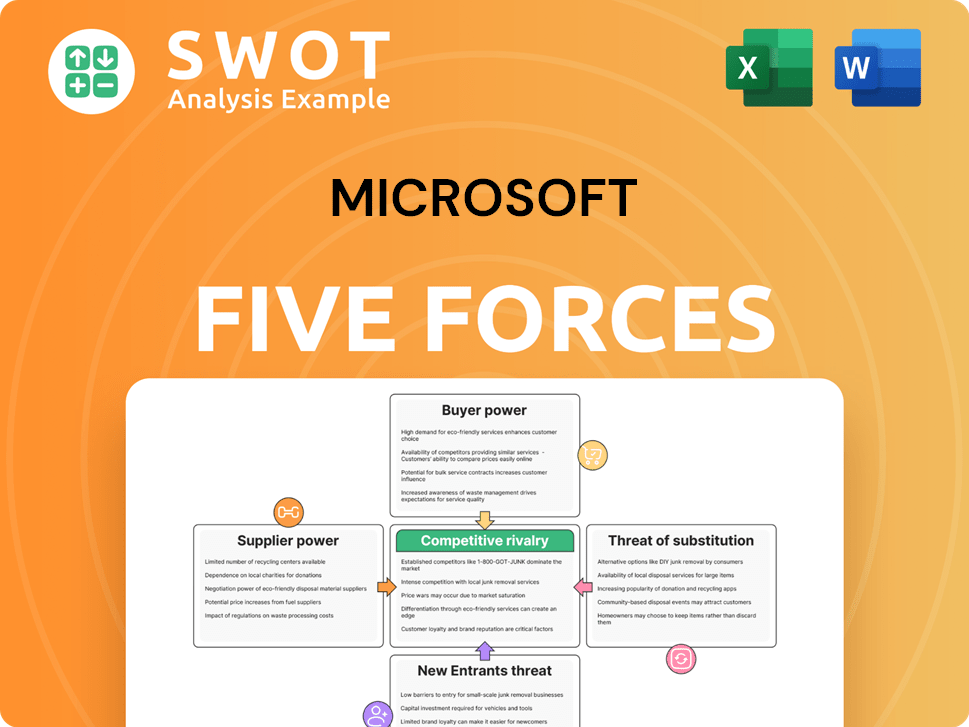
Related Blogs
- What is Competitive Landscape of Microsoft Company?
- What is Growth Strategy and Future Prospects of Microsoft Company?
- How Does Microsoft Company Work?
- What is Sales and Marketing Strategy of Microsoft Company?
- What is Brief History of Microsoft Company?
- Who Owns Microsoft Company?
- What is Customer Demographics and Target Market of Microsoft Company?
Disclaimer
All information, articles, and product details provided on this website are for general informational and educational purposes only. We do not claim any ownership over, nor do we intend to infringe upon, any trademarks, copyrights, logos, brand names, or other intellectual property mentioned or depicted on this site. Such intellectual property remains the property of its respective owners, and any references here are made solely for identification or informational purposes, without implying any affiliation, endorsement, or partnership.
We make no representations or warranties, express or implied, regarding the accuracy, completeness, or suitability of any content or products presented. Nothing on this website should be construed as legal, tax, investment, financial, medical, or other professional advice. In addition, no part of this site—including articles or product references—constitutes a solicitation, recommendation, endorsement, advertisement, or offer to buy or sell any securities, franchises, or other financial instruments, particularly in jurisdictions where such activity would be unlawful.
All content is of a general nature and may not address the specific circumstances of any individual or entity. It is not a substitute for professional advice or services. Any actions you take based on the information provided here are strictly at your own risk. You accept full responsibility for any decisions or outcomes arising from your use of this website and agree to release us from any liability in connection with your use of, or reliance upon, the content or products found herein.